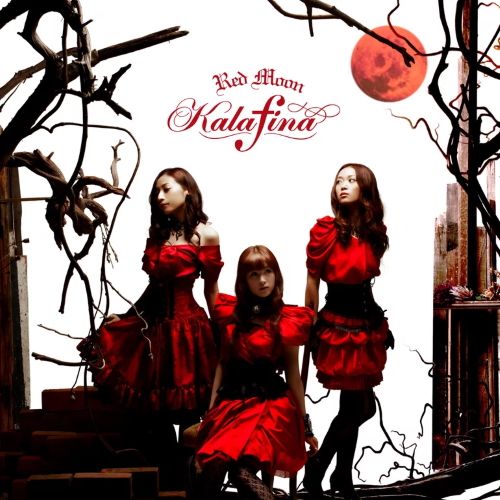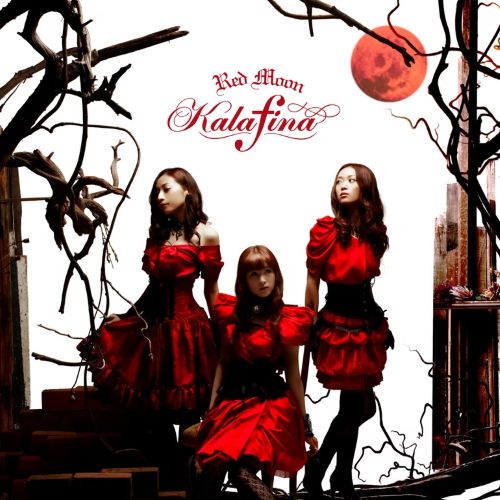A retrospective on Red Moon

Firstly, I’d like to thank all the people who responded to my previous article for your kind words. Writing on an old-fashioned style blog makes you wonder “is anyone reading this and getting anything positive out of it?”, and I have a compulsion to double-check the smallest details over and over, worry that I’m giving the right people enough credit, etc.. Welcome to my Draft Rewrite Hell ;p
Again, this isn’t an album review per se. At this point in time, I find it more interesting to view these songs in terms of where they stand in the band’s back catalogue, and what those songs mean to them – and us – today.

After Maya’s departure, the line-up stabilised into the three-way vocal section of Wakana, Keiko and Hikaru. Although there was a larger number of contributors to the studio recordings, the live support band was pretty much the same one that they would work with for the next nine years.
Their status as an “anisong” band continued, although I don’t know whether this was thanks to the success of their first album’s singles, or simply because they were one of Yuki Kajiura’s active projects. She was still working under the “FictionJunction” name too, so I suspect that Kalafina were already popular on their own merits, and it probably provided her with a slightly different creative outlet as well.
The most obvious change was that they were no longer “The Garden of Sinners movie soundtrack band,” but they also made live performances an integral part of their regular activities. Progressive was one of the songs that marked the shift in emphasis: Kajiura admits in the Kalafina Record interviews that it was not written specifically for concert performances, but she did find inspiration for it after seeing them performing live shows.
Being “a good studio band” and “a good live band” aren’t necessarily the same thing however, and it’s often harder to achieve the latter than the former. A common issue with studio projects – especially those that specialise in soundtrack work – is recreating their sound in a live setting, and this is when Kalafina faced that challenge.
There are signs throughout the album that Kajiura is trying out more elaborate arrangements, and that the singers are in turn working hard to achieve this, both individually and together…which meant an emphasis on harmonising in real time rather than overdubbing separately in the studio. I was lucky enough to hear Red Moon’s title track performed during their final major concert in 2018, and I have to say that the studio version really doesn’t capture the full experience of hearing it in a large live venue.
Like Seventh Heaven before it (and a lot of other artists’ music released around the same time), the album was mastered with rather heavy dynamic compression: a technique that reduces the difference in volume between the quietest and loudest moments in a song. This is common for commercial rock and pop albums though, especially those that need to sound as loud as everything else that’s played on the radio and TV. How much it affects your enjoyment is subjective, but I think that this is why I enjoyed the live performance so much (for those interested, I’ve done a “deep dive” analysis into the differences between the original versions of numerous Kalafina songs and the remastered All Time Best, which was released in 2018. Although there are measurable differences to the sound because of the remastering, I’ll let individual listeners decide whether they’re noticeable or not).
Either way, Red Moon sounds…huge. It really feels like it was written to be performed in a stadium-sized space where the numerous instruments need room to make themselves heard, much like an operatic or symphonic piece: there’s electric guitar, drums, backing choral chanting, and a full strings section. The vocals alternate between solo lines and doubled choruses, finishing on a glorious crescendo of coined “Kajiura-go” lyrics where Keiko reaches down into her lower registers and launches the melody up to the top of her range before Wakana takes a higher melody and lets it drift gently back down to earth.
The overall impression is that of a towering “sonic cathedral” with mysterious shadows, soaring heights, epic reverberations and dazzling splashes of colour. It’s also interesting to see such a bold statement as the album’s opener.
Like several other tracks, such as Yami no Uta and Lacrimosa, the title track sounds bolder and more ambitious than anything on their first record. Considering that Lacrimosa and Seventh Heaven were released on the same day, it struck me as odd that the single wasn’t included on the album. In retrospect, this “bigger” and more dramatic sound is better suited to Red Moon, and since it was written for an anime completely unconnected to The Garden of Sinners, I suppose it doesn’t really fit in with the theme either. Seventh Heaven stands as a concept album of sorts (I’m told that some of the lyrics in Fairytale and the title track were taken directly from text in the original novel) while Red Moon marks the next phase in the band’s career. In hindsight, the decision over Lacrimosa makes more sense to me.
Hikari no Senritsu, one of the songs that they played frequently at live shows, feels like a bit of an outlier. It does have some melancholic undercurrents, but the lilting flute and brisk acoustic guitar make it sound superficially playful and joyous (which is all quite appropriate given the atmosphere and underlying themes of the Sora no Woto anime show that it was written for). The pastoral vibe of that song is quite different from the rest, but it forms a contrast to the opening title track and the more intense content that follows.
All of Red Moon’s singles, with the exception of Progressive, were “tie-in” theme songs, as was the closing track I have a dream, which was used for the ending credits of the feature film version of The Time of Eve that premiered in cinemas a couple of weeks before the album itself was released.
What deserves special mention here is Storia: the first of several Kalafina songs that Kajiura wrote as part of her soundtracks commissioned for the Rekishi Hiwa Historia documentary TV series. The distinctive mood of their “Historia” songs, later shared by Symphonia, Yume no Daichi and Into the World, added another dimension to the styles and genres that would later appear in their back catalogue. Today is the date of the final episode’s broadcast, and according to the social media activity the coincidence wasn’t lost on Kajiura, or members of the band. They shared their thoughts on both the song and the TV show on social media, even posting photos of bottles of commemorative “Historia” wine, which really indicates how important this was to them.
Although the main songwriter was already experienced, they were a relatively new band back then, so they were still in the process of establishing themselves. They were expanding on what the “Kalafina sound” meant, while at the same time setting themselves apart from the more general “Kajiura sound” that already had its brand identity in the industry.
The “genre mashup” approach mirrors that of her solo soundtrack work and her FictionJunction tracks, but even as it jumps from tender ballad to symphonic rock to synthpop and back again, the end result is not as inconsistent as you might expect. This experimentation pays off I think because of Kajiura’s confidence and the performers’ desire to push themselves: the whole venture would never have succeeded with just one or the other. It helped them to grow beyond the confines of one movie franchise, and also allowed them to make more appearances outside of the studio and on the stage. I can see why they would all want to raise a glass to that.
